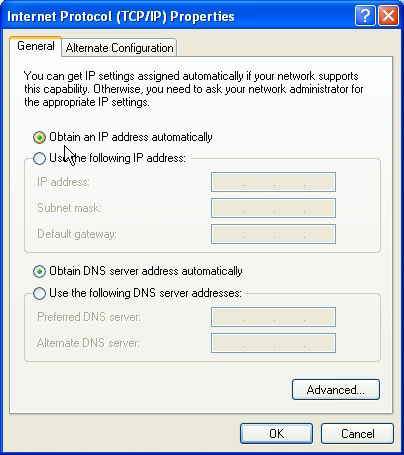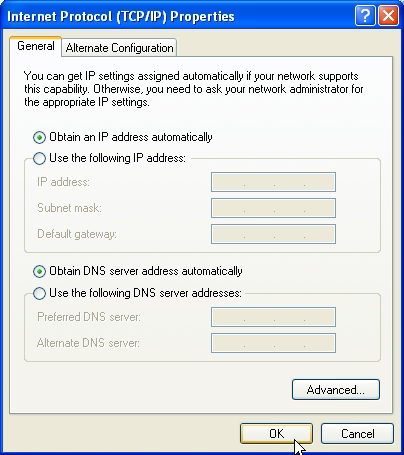What is the matter?
The hardware for internet or network connection is in place, but you nevertheless have no connection to your Service Provider and the Internet.
What should I do?
Follow the steps below. Click on a step for a screenshot or more information
- Go to Control Panel.
If you have Windows XP view: click Start > Control Panel
If you have Classic view: click Start > Settings Control Panel

Classic view:

- Click 'Network Connections'. A new window opens.
In 'Control Panel', click 'Network Connections'.

A new window, named 'Network Connections' will open.
- Click 'Local Area Connection' (or 'Wireless Network Connection'). A new window opens.
In the window 'Network Connections', click 'Local Area Connection'.
If you connect wireless, choose 'Wireless Network Connection' instead of 'Local Area Connection'. The names of the windows in the following steps will differ accordingly.

- If the window 'Local Area* Connection Status' has opened, click 'Properties'
If the window 'Local Area* Connection Properties' already has opened, skip this step.
This step is only necessary if the window 'Local Area* Connection Status' has opened. In some cases, the window 'Local Area* Connection Properties has already opened straight away.

- Select 'Internet Protocol (TCP/IP)'.
In the window 'Local Area* Connection Properties' > tab 'General' > select 'Internet Protocol (TCP/IP)'.

- Click 'Properties'. A new window opens.

A new window 'Internet Protocol (TCP/IP) Properties' will open.
- Select 'Obtain an IP address automatically'.
Note: if a specific address (numbers) is entered in the fields, read here first!

In the window 'Internet Protocol (TCP/IP) Properties', tab 'General', select 'Obtain an IP address automatically'. This is the default setting.
However, in some cases, it may be neccessary to specify addresses. If 'Use the following IP adress' is selected and a specified adresses is entered, this settings probably is necessary to connect to your preferential network, e.g. at home.
When you have chosen 'Obtain an IP address automatically', you might experience connection problems on your preferential network.
When you select 'automatic obtaining of IP address', the specified number might disappear. To avoid this, note the entered number before you click 'Obtain... automatically'! This enables you to re-enter the number when you want to connect to your preferential network.
- Click 'OK', also close the windows 'Local Area* Connection Properties'and 'Network Connections'.

- Check if it solved the problem.
Again try to run the web site. If necessary refresh the page or additionally shut down and restart the browser (=e.g. Internet Explorer). If the problem is not yet solved, return to the page you came from, or to the CASK FAQ main page and check other problem causes.
Background
An IP (Internet Protocol) address is a number that identifies your computer on a network or on the Internet. Dependent on the Service Provider, your computer will have a fixed IP adress, or it will be automatically assigned an IP address upon connecting to the network. If an IP address mismatch occurs, you will not be able to connect to the network or to the Internet.
If you use your computer on different networks, e.g. at home and at the University, the requirements regarding the setting for IP address may also differ. Consequentially, you may not be able to connect to the alternative network unless you adapt these settings.
If you use your computer on different networks, e.g. at home and at the University, the requirements regarding the setting for IP address may also differ. Consequentially, you may not be able to connect to the alternative network unless you adapt these settings.
Last updated: